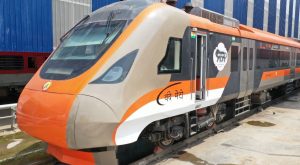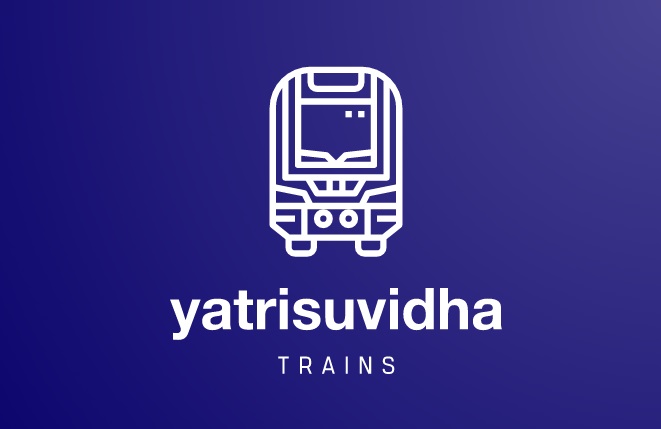
The Vande Metro train, India’s latest addition to its growing list of semi-high-speed trains, is designed to provide rapid and comfortable short-distance travel for commuters across various urban and suburban routes. It is a sibling project of the popular Vande Bharat Express and aims to bridge the gap for travelers who need a more accessible, efficient travel option within metropolitan regions. Here’s a comprehensive look into every aspect of the Vande Metro:
- Overview of the Vande Metro Project
The Vande Metro project was conceptualized to cater to India’s expanding urban commuter population. Unlike the Vande Bharat Express, which focuses on intercity travel over relatively longer distances, Vande Metro aims at short, high-frequency routes connecting satellite towns and nearby urban areas. This train aims to offer a comfortable, modern alternative to current suburban train services and relieve congestion in highly populated areas.
The Vande Metro is designed to:
Operate within city limits and between nearby urban hubs.
Provide high-frequency, quick-service options for daily commuters.
Offer a blend of speed, comfort, and affordability tailored for shorter journeys.
- Design and Features
The Vande Metro trains have been developed using similar technologies as the Vande Bharat Express. The design prioritizes comfort, speed, and durability. Some of its key design elements and features include:
Train Structure: Like the Vande Bharat Express, the Vande Metro is an all-air-conditioned train with an aerodynamic, sleek body structure designed to minimize air resistance.
Interior Layout: The seats are designed for short-distance comfort, with ergonomic features and sufficient legroom, catering to both sitting and standing passengers.
Passenger Amenities: The train features charging ports, Wi-Fi access, LED lighting, and information display screens. Restrooms are designed with cleanliness and efficiency in mind.
Automatic Doors and CCTV Surveillance: Equipped with automated doors for safety and surveillance cameras for security.
Energy Efficiency: Vande Metro incorporates energy-saving technologies, such as regenerative braking systems.
- Speed and Performance
One of the key objectives of the Vande Metro is to operate at high speeds within metropolitan regions. While it does not reach the maximum speeds of the Vande Bharat Express, Vande Metro’s design allows for:
Top Speed: Expected maximum speeds are around 130–140 km/h, depending on the track conditions and route requirements.
Acceleration and Deceleration: Optimized for frequent stops, Vande Metro is equipped with advanced braking systems to ensure rapid acceleration and deceleration.
Journey Time Efficiency: The Vande Metro is expected to complete journeys in significantly shorter times compared to traditional suburban trains, reducing travel time by approximately 30–40% on average.
- Routes and Destinations
The Vande Metro network is planned to connect multiple urban and suburban centers across various Indian cities. While the routes are still being expanded, several metro cities and their adjoining areas are in the pipeline:
Delhi NCR: Connecting New Delhi with nearby cities like Gurgaon, Noida, Ghaziabad, and Meerut.
Mumbai Metropolitan Region (MMR): Routes include connectivity between Mumbai and nearby cities such as Navi Mumbai, Thane, and Pune.
Chennai Metropolitan Area: Routes within Chennai and neighboring districts, including Chengalpattu and Kanchipuram.
Kolkata Metropolitan Region: Plans include routes connecting Howrah, Sealdah, and other suburbs around Kolkata.
This network will likely expand further into other high-traffic areas like Bengaluru, Hyderabad, and Ahmedabad, where similar regional connectivity is essential.
- Ticket Pricing Structure
Vande Metro ticket pricing is intended to be affordable for daily commuters while offering added amenities over traditional commuter trains. The ticketing structure may vary slightly based on route distance, time of travel, and seating class. However, general expectations include:
Base Fare: Estimated around ₹15–₹50 for shorter routes (10–20 km), aimed at making it competitive with metro rail pricing.
Longer Routes: For longer routes within metropolitan areas (50–100 km), fares might range from ₹60–₹200.
Class Options: The train is expected to feature two classes—Standard and Premium. Premium class will offer additional seating comfort and space, while Standard class focuses on affordability.
Monthly and weekly passes may also be introduced for frequent travelers, making it economical for daily commuting.
- Booking Process
The ticket booking process for Vande Metro is designed to be convenient and accessible, with various methods available:
Mobile App and Website: Tickets can be booked via a dedicated app or the Indian Railways website. Users can select seats, check train schedules, and make payments online.
Physical Counters and ATVMs: Automatic Ticket Vending Machines (ATVMs) at stations will offer an easy way to book tickets quickly. Physical booking counters will also be available for those who prefer traditional booking.
Smart Cards and Contactless Payments: To make commuting easier, smart cards and contactless payment options will be provided, similar to those used in metro rail systems.
- Schedule and Frequency
The Vande Metro’s schedule aims to address peak-hour traffic and ensure a consistent flow of services throughout the day. Expected schedules and frequency include:
High Frequency During Peak Hours: Trains are likely to run every 10–15 minutes during peak hours (7:00 AM–10:00 AM and 5:00 PM–8:00 PM).
Off-Peak Hours: Reduced frequency of around 20–30 minutes during off-peak hours.
Night Services: Limited services may be available late at night, especially on high-demand routes.
- Safety and Security Measures
Safety is a top priority for the Vande Metro. Its design and operational protocols include multiple layers of security for passengers:
Onboard CCTV Monitoring: All compartments are equipped with CCTV cameras.
Automated Emergency Brakes: The trains have emergency braking systems that automatically activate in case of potential hazards.
Fire Safety and Medical Kits: Trains are equipped with fire detection and suppression systems, along with medical kits in case of emergencies.
Staff and Security Personnel: Trains are staffed with security personnel, especially during peak hours, to ensure a safe environment for passengers.
- Environmental Impact
The Vande Metro trains are also environmentally friendly, designed with energy-saving measures and a lower carbon footprint:
Electric Locomotion: Fully electric, reducing reliance on fossil fuels and lowering emissions.
Regenerative Braking: This system not only improves energy efficiency but also helps reduce power consumption.
Sustainable Construction: Coaches are built with recyclable materials, minimizing waste and promoting a sustainable manufacturing approach.
- Future Expansion and Development
The Vande Metro project is only in its initial stages, and further expansion plans are in the works. Future plans include:
Expansion to Additional Cities: After the successful implementation in major cities, Indian Railways plans to introduce Vande Metro in Tier-II and Tier-III cities.
Integration with Existing Transit Systems: Indian Railways is exploring options to integrate Vande Metro services with metro and bus networks for seamless urban transit.
Increased Frequency and More Routes: As demand grows, there are plans to increase service frequency and add more routes to cover additional areas.
- Comparison with Other Train Services
The Vande Metro brings a distinct advantage in terms of speed and comfort compared to other regional and suburban train options:
Vande Bharat Express vs. Vande Metro: While both belong to the same family, Vande Bharat Express caters to intercity travel, while Vande Metro is dedicated to short, urban commutes.
Metro Rail Systems vs. Vande Metro: Metro rail systems generally cover shorter distances within city centers, while Vande Metro targets suburban areas, bridging longer distances and high-demand urban routes.
The Vande Metro marks an essential step in modernizing India’s urban transportation infrastructure. With its focus on speed, efficiency, and affordability, the Vande Metro is poised to become a popular choice among daily commuters in metropolitan areas.

Leave a Reply